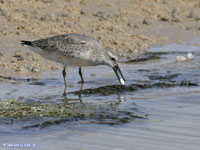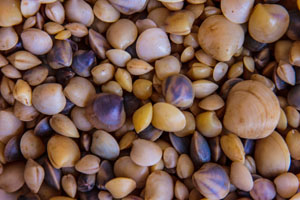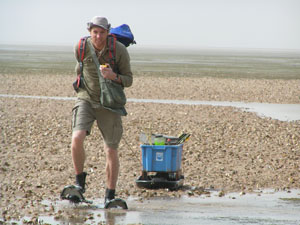Red Knot trapped in food web

The numerous knots that spend the winter in Banc d’Arguin, an area of sandy shallows in Mauritania, are having difficulty finding enough food. They rely on a complex food web, consisting of sea grass, sulphur bacteria and various species of shellfish. Biologist Matthijs van der Geest from the Royal Netherlands Institute for Sea Research NIOZ has analyzed this food web. He will be awarded a PhD by the University of Groningen on 15 November.

The red knots (or simply knots) that Van der Geest studied migrate from the Banc d’Arguin, via the Wadden Sea, to breeding grounds in Siberia and back every year. Biologists have spent years trying to work out how the birds manage this exceptionally long journey.
Low in food
‘One of the main open questions is where exactly the food they find on the Banc d’Arguin comes from?’ says Van der Geest. This relatively small area of shallows (500 square kilometres, compared with 2,400 square kilometres for the entire Dutch Wadden Sea) located between the desert and the ocean is very low on food.
The Banc d’Arguin is marked by extensive fields of sea grass, which is inedible to the shellfish on which the knots feed. ‘But the sea grass produces organic waste’, explains Van der Geest. The waste is broken down, releasing sulphide, a substance that is toxic for many organisms. However some bacteria use this sulphur compound to obtain the energy they need to produce sugars.
Toxic
‘Our research shows that bacteria of this type live in the gills of the bivalve Loripes lucinalis’, Van der Geest continues. He discovered that approximately 80 percent of the carbon that this mollusc feeds on comes from these symbiotic sulphur bacteria. The Loripes obtains the rest of its food by filtering algae from the water.
The Loripes is common on the Banc d’Arguin and so it seemed logical that it would be part of the knots’ staple diet. ‘That was until field research showed us that Loripes is poisonous to birds. If the shellfish constitute more than half of the birds’ diet, they develop diarrhoea, probably because of the sulphur bacteria living in their gills.’
Production of shellfish meat
So Van der Geest transferred his attention to a second shellfish species: Dosinia. ‘This shellfish feeds exclusively on algae filtered from the water.’ Knots supplement their diet with Dosinia. There was a clear positive link between the prevalence of Dosinia in certain years and the survival rate of the knots.
Van der Geest also discovered that both types of shellfish grew more slowly when the density in the field was doubled in experiments. ‘The density of the shells increases if there are no predators. This curbs the growth of the shellfish, so the production speed of shellfish meat is actually higher when knots are present to eat them.’
Subtle web
So a subtle web of interactions between knots and prey has evolved, in which sulphur bacteria and sea grass play an important part. But Van der Geest concludes that the overall picture does not look promising for the knot. ‘The joint production of Dosinia and Loripes is just enough to feed the knots that winter on the Banc d’Arguin, as long as they are the only animals eating the shells. But this is not the case.’
Not a tropical paradise
The Banc d’Arguin is anything but a tropical paradise, where red knots can drop in to build up their strength. ‘We simply don’t think that there’s enough food for them to forage. The birds need to fatten up, store enough energy for their flight. It’s often impossible.’
‘We always thought the Wadden Sea was a bottleneck that knots had to negotiate, and that they would be all right as long as they found enough to eat here. But the Banc d’Arguin appears to be the current bottleneck’, says Van der Geest. ‘Furthermore, we now know that the birds increase the production speed of their own food. This could also be true in the Wadden Sea.’
Curriculum Vitae
Matthijs van der Geest studied biology at the University of Groningen and conducted his research (with an NWO-WOTRO Science for Global Development Integrated Programme grant) at the Royal Netherlands Institute for Sea Research NIOZ on Texel, and at the University of Groningen, Centre for Ecological and Evolutionary Studies (CEES) . He will be awarded a PhD in Mathematics and Natural Sciences. His promotors are Theunis Piersma (RUG en NIOZ), Jaap van der Meer (VU) en Han Olff (RUG).
More news
-
11 December 2025
Stormy planets and an unexpected atmosphere
-
09 December 2025
Faculty of Impact Grant for new brain cancer treatment
